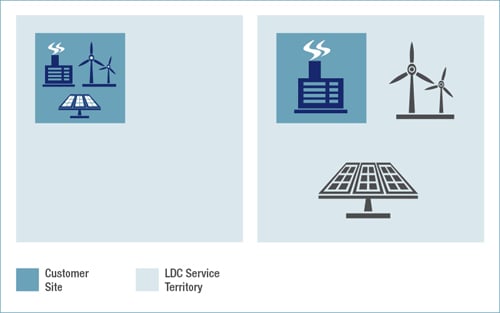Courtesy of Borden Ladner Gervais. View original article here.
On December 22, 2016, the Ontario Ministry of Energy (the “Ministry”) posted an update to its August 19, 2016 regulatory proposal for revising the Net Metering Regulation: O. Reg. 541/05 (the “Regulation”). The Regulation established a province-wide net metering program in 2005 (the “Program”) by requiring electricity distributors to offer net metering to their customers upon request.
Under the Program, Ontario electricity consumers who generate electricity for their own consumption through renewable sources (e.g. solar, wind, hydro, biomass) may convey any excess energy into the grid. These consumers are eligible to receive a bill credit for the “net” difference between the value of electricity supplied to the grid and the value of electricity taken from the grid, which can be carried forward to offset future electricity costs.
The Program is of interest to load customers who are looking for opportunities to reduce their electricity bills by installing renewable generation facilities and to developers and providers of such facilities.
In its December 22, 2016 updated regulatory proposal, the Ministry included all of the proposed amendments which formed part of the August 19, 2016 regulatory proposal (the “Original Proposal”), including eliminating the 500kW system capacity restriction and permitting electricity storage, except for establishing a billing method for single-entity virtual net metering (i.e. credit transfers between multiple electricity accounts held by the same person or corporation) subject to account meters being located within the same electricity distributor service territory and within a maximum distance. This would create opportunity for load customers to get the benefit of net metering by building a renewable energy generation facility offsite, provided it is located in the same local distribution company’s service territory and is owned by the same owner, as depicted below. The Ministry removed this element of its proposal entirely, which was identified as requiring additional feedback and consideration of design elements through upcoming consultations.
 |
| Figure 1: Under the Original Proposal, establishing a billing method for single-entity virtual net metering would allow a renewable energy generation facility to be located outside the customer site as long as it is within the LDC service territory. |
Background: The Original Proposal
As part of the 2013 Long-Term Energy Plan, the Province of Ontario committed to examining the potential for the microFIT program to evolve from a generation purchasing program to a net metering program.
In the Original Proposal, the Ministry proposed the following amendments to the Regulation:
- The requirement that the equipment used to generate electricity be no greater than 500 kW, based on the rated maximum output capacity of the equipment, would be removed;
- Storage and remittance of electricity from the electricity distribution system and from a renewable energy system would be permitted;
- Generators would be compensated on the same basis as they are charged for consumption of electricity as consumers (i.e. volumetric electricity charges);
- Electricity distributors would be required to carry forward positive bill credits for net-metered accounts for a consecutive 12-month period, extending the current 11-month credit carryover period;
- A billing method for single-entity virtual net metering (credit transfers between multiple electricity accounts held by the same person or corporation), subject to account meters being located within the same electricity distributor service territory and within a maximum distance (e.g. a 3 kilometer radius) would be established; and
- Participants who have existing net metering agreements prior to the effective date of the proposed revised Regulation would have the option of entering into new agreements reflecting updated provisions or maintaining their existing agreements.
Next Steps
The proposed revised Regulation is expected to be in force on July 1, 2017.
The Ministry will be hosting a Webinar on January 12, 2017 at 1:30 pm.
Webinar Details
Title: Potential Updates to Ontario’s Net Metering Program: Third-Party Ownership and Virtual Net Metering
Date and time: Thursday, January 12, 2017, 1:30pm EST
Duration: 1 hour 30 minutes
Stakeholders interested in third-party ownership and virtual net metering, including single-entity virtual net metering and multi-entity virtual net metering (also known as “community net metering”), should attend.
The Ministry has stated that consultations on additional net metering program design elements that may require amendments to the Ontario Energy Board Act, 1998 which were planned for Fall 2016 will commence in early 2017. These consultations will give consideration to virtual net metering programs, including single-entity virtual net metering and multi-entity virtual net metering, and third-party ownership.
Program Implementation and Evaluation
Along with the proposed amendments to the Regulation, the Ministry is also looking to conduct a cost-benefit evaluation of the Program every three years on an as-required basis, improving availability of information on the Program, and analyzing whether investments in Ontario’s Meter Data Management and Repository should be made to enable province-wide time-of-use billing for residential and general service (<50 kW) net metered customers.
The Ontario Energy Board has been tasked with exploring ways to facilitate and streamline implementation of the Program, such as drafting a standardized net metering application and agreement, and collecting net metering information from electricity distributors at more frequent intervals to monitor Program implementation.
Courtesy of Borden Ladner Gervais. View original article here.